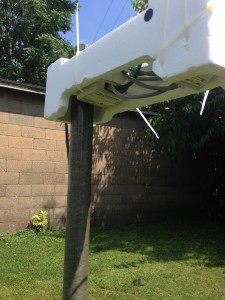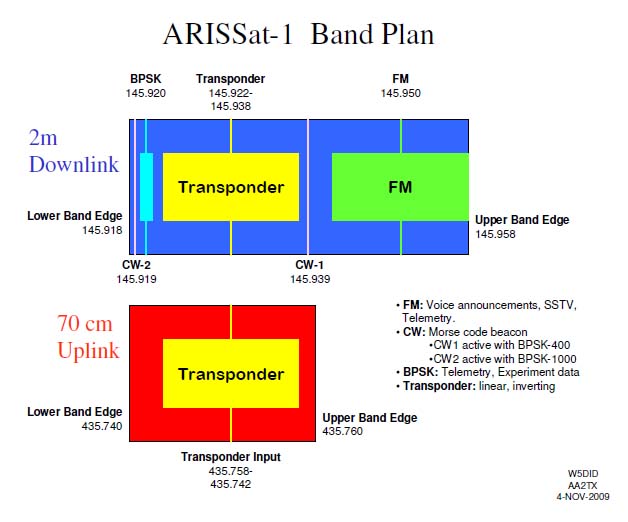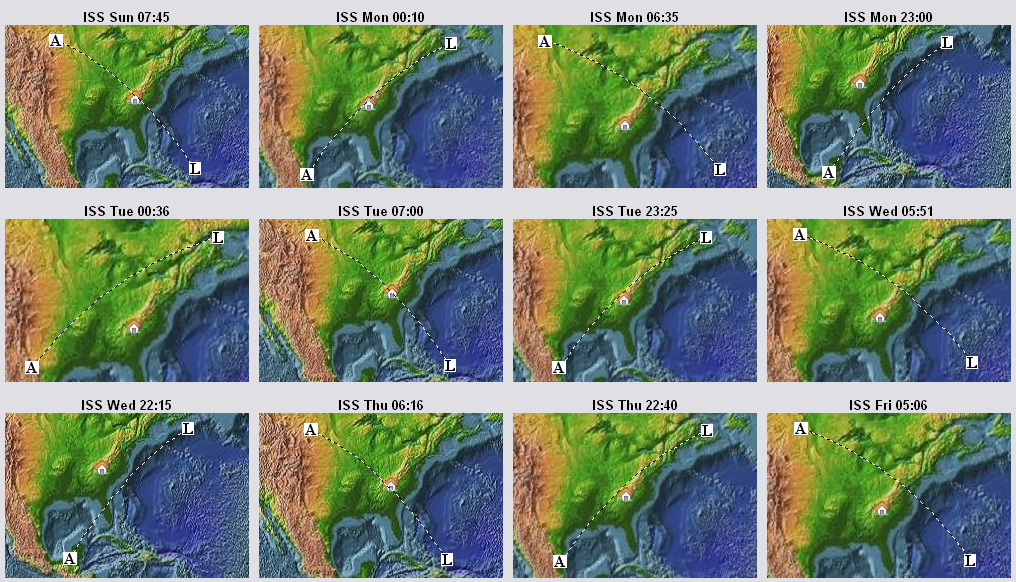Finally got my new domain name secured in! I’ll be implementing changes to reflect that soon. The domain is k8j.sm.
Category Archives: News
APRS iGate
Set up my laptop with one of my radios to act as an iGate (K8JSM), which uploads RF APRS data to APRS-IS. There aren’t many in my area, so it’s nice to have a little coverage, even if it’s just temporary. http://aprs.fi/
1-wire Wx Station Testing

Set out the 1-wire wx station to calibrate the sensors before mounting them in any semi-permanent way. My anemometer and windvane are placed between my and my neighbor’s house. It is a less than ideal position, but the length of ethernet cable is limited with this particular setup. So far, I have done one calibration on the three (of four) thermometers in my station, two contained in the Temperature/Humidity/Solar sensor and one contained in the Barometer. I recently repositioned those three thermometers to my back yard, from my driveway (which gave far too high temperature readings). I also created a makeshift radiation shield made from styrofoam and zipties.
I also updated the Website in a few places to show my weather data and webcam. You can see my weather data on the right side of the Home page of my Website and on the Weather page. The data is also transmitting to APRS-IS (Automatic Packet Reporting System) via Internet (this is considered “APRSWXNET“), which is then fed to the CWOP (Citizens Weather Observation Program), which is used by the NWS (National Weather Service) via the MADIS Program for forecasting and other purposes.
Slight Updates
Made a few modest updates relating to my personal (1-wire) weather station (mainly the Website). Plan to tower-mount it as soon as possible. Data being sent to APRS-IS and WunderGround. Data visible in the right hand column and on the Weather page. Also added APRS tracking to the right hand column that shows my position as I am using APRS in my vehicle (storm chasing or otherwise).
Sean
Happy 2012
Happy New Year’s!
Sorry I haven’t updated that much lately, but it hasn’t been convenient. Hoping everyone stays “radio active” in to 2012.
NAQP Contest
The North American QSO Party is coming up from 1800Z August 20 to 0600Z August 21, 2011 (Third full weekend in August). I haven’t been keeping up on contesting like I wanted to for the site, but this one should be good fun if you can get on the air. Check the National Contest Journal’s Website for more information on rules, submissions, categories, and results.
From the NCJ Website:
The North American QSO Parties are favorites of beginners and seasoned operators alike. With their low-power only, multipliers-per-band format, these contests allow stations from all parts of North America to be in the running for the top spots. And their 10/12 hour format allows participants to do some great contesting and still have time for other activities during the weekend! Participants can enter in the single op or multi-op categories and have the opportunity to combine up to five separate single op scores into a team score.
Also, power and band restrictions are notable:
Output power must be limited to 100 watts for eligible entries. Use of external amplifiers capable of more than 100 watts output is not allowed.
Bands: 160, 80, 40, 20, 15, 10 meters only, except no 160 meters for the RTTY contest. You may work a station once per band.
Suggested frequencies are 1815, 3535, 7035, 14035, 21035 and 28035 kHz (35 kHz up from band edge for Novice/Tech) on CW; and 1865, 3850, 7225, 14250, 21300, 28500 kHz (28450 for Novice/Tech) on SSB.
When operating on 160-meters, please respect the DX window of 1830-1840 kHz and keep SSB operations above 1840 kHz.
Exchange and multiplier information:
Exchange: Operator name and station location (state, province or country) for North American stations; operator name only for non-North American stations. If the name sent is changed during the contest, as sometimes happens with multi-operator stations, the name used for each QSO must be clearly identified in the log.
Multipliers: Are U.S. states (including KH6 and KL7), 13 Canadian provinces/territories (British Columbia, Alberta, Saskatchewan, Manitoba, Ontario, Quebec, New Brunswick, Nova Scotia, PEI, Newfoundland/Labrador, Yukon, NWT and Nunavut) and other North American countries. District of Columbia counts as Maryland. Non-North American countries, maritime mobiles and aeronautical mobiles do not count as multipliers, but may be worked for QSO credit.
I find this contest to be a lot of fun, and there is certainly a lot of activity to enjoy. If you get the chance to listen to or participate in it, go for it. I might even build a couple of antennas just for this contest and ask a friend to combine with me as a team station. Good luck!
Being Digitally Connected Can Prove Vital
Seems that lately, my attention has been on interconnection, with specific regard towards being connected to each other through technology in some way or another. Most people that I’m around have some sort of cell phone, and a majority of those, a smart phone. I’ve been going a lot further than that.
Being a radio amateur gives me the privilege of playing with technologies a little bit more; such as creating extra strong WiFi networks over large areas, monitoring weather, to help give real time in-the-field observations to the National Weather Service, or playing with the raw materials, such as building antennas, all in hopes of making my radio ability and effectiveness better.
Being up on these skills means that, when we need it, I’m there to help establish radio communications, understand basically how they work, and perhaps even be able to help reestablish radio systems. With a general class amateur radio license, I have many frequencies, including high frequencies (HF), available for use, which essentially means that I can more easily communicate over short or “long” distances, such as state-to-state, region-to-region, or country-to-country.
With the first level of amateur radio license, the technician level, one has privilege to transmit on one HF band of radio, similar to the Citizens Band radio service, which is 10-meters in length. It has potential to travel long distances, such as from Ohio to Florida, or even further, to Costa Rica, during times of minimal and moderate solar activity, and has been known to take world paths, circling the globe due to extra good propagation conditions. It’s also good for local contacts, especially via ground wave propagation, where the radio signal travels from your antenna, usually vertically, along the terrain, and is received at the other station’s antenna. That’s how the common CB effectively works.
I’m hoping that I can encourage more people to become aware of the hobby and take advantage of it as a way to constructively relieve stress, learning a skill that can certainly be used towards helping the general good of man. We’re helping to experiment and advance wireless technologies.
To go further, check out my page for those who are New to Radio.
Severe Wx
Lately, I’ve been getting back in to SKYWARN severe weather spotting around Coshocton County, Ohio. It’s been a good bit of fun getting my portable wx station set up, but the really fun part is using it! (To see my portable wx station, click here.)
I still need to devise a way to latch this sucker down in very high winds. I’m experimenting with bungee cords and the roof of my car, but in the last storm, I didn’t have enough bungees to properly secure it, so I had to disengage it and just go without any data. Unfortunately, in my county, AT&T does not offer any coverage whatsoever, and I have no cell data available to me, so I can’t even view a radar image. It SUCKS, but I’m working on getting my own large area WiFi signal out, so I can access the Internet that way on my iPhone or netbook laptop.
I’ll post some pictures and updates about my trials and tribulations with the wx station as they become available (meaning, if I’m not being blown around in 40MPH winds, losing my hat, and trying to keep my station from falling over)!
ARISSat-1 (RS01S) Activation
HEY!! READ THIS!!
The astronauts on board the International Space Station will activate and use the ARISSat-1 as a test, from April 11-13. Here is more from the ARISSat-1 Website.
The ARISSat-1 satellite, presently still inside the ISS, will be turned on and use an external antenna on 12 April 2011 to celebrate the 50th anniversary of Yuri Gagarin’s first manned space flight. AMSAT will support this event and issue certificates to those stations reporting reception of the ARISSat-1 signals. Roscosmos has announced that the satellite will be deployed into orbit during the next EVA in July of this year.
The satellite’s call sign is RS01S. The operation will be from April 11 at 1500 Zulu to April 13 at 1030 Zulu. (Zulu time is the same as Universal Coordinated Time [UTC].) The satellite follows the following band plan, so listen on 145.950MHz.

If you plan to try to receive the satellite’s transmissions, try using a directional antenna, like a hand held yagi. It will greatly increase your chances. You can use this image to track the ISS.
Here, courtesy of Ham Radio Deluxe, are projected passes over my current North Carolina QTH. It can prove useful for the East Coast stations reading this, I’m sure. This is over the projected dates of transmission, and in Eastern Daylight Savings Time. Click the image to see a larger view. Please don’t permalink to my images, though.
Again, if you try to hear the satellite, use a handheld transceiver connected with a handheld yagi or other directional antenna, and use the pass prediction images to help you aim your antenna. Listen with your squelch full open and keep in mind, if the satellite is approaching, you may want to shift your receiver frequency down 10-50kHz, and if departing, up 10-50kHz to hear better. Have a pencil and paper ready to record anything you hear, such as call sign and other information being transmitted. Good luck!
W4S Titanic Special Event Station
To commemorate the 99th anniversary of the sinking of the RMS Titanic, radio amateurs will be setting up and operating a special event station at the site of the Titanic Museum, in Pigeon Forge, TN, from 1200 EDST on the 9th to 1200 EDST on the 10th. They will be operating on or about 3.760 & 3.850, 7.152 & 7.225, 14.250, and 28.400 (all frequencies are in MHz).
Be sure to make an effort to work this station, especially if you have a young one around who happens to be interested in the Titanic or if you collect QSL cards!
From the W4S Titanic Special Event Website:
The Amateur Radio Operators will be setting up on the 9th & 10th,of April, under the call of W4S, special event station, the time frame is from 12:00 noon on the 9th to 12:00 noon on the 10th,Saturday and Sunday, on these two days, for the 99th anniversary of the sinking of the Titanic, this will be a international event to contact amateur radio stations all over the world..TenTec will be furnishing us the new TenTec Eagle to use for this great event that will be the first time held here in the Great Smoky Mountains of Tennessee. We will have a web-cam setup along with TV and Radio coverage of this event, QST will also cover the event. We will be setup directly in front of the attraction on Hwy 441 in Pigeon Forge TN, we are looking for amateurs who would like to operate and hope that everyone will attend and join in on the event. Frequencies to be used…3.760 & 3.850, 7.152 & 7.225, 14.250, 28.400, of course do to other traffic that may be using the frequency may vary +/- some… If you are interested in operating the Titanic event 2011 April 9-10 please send a e mail to me at the e mail below…..vendors can also contact me at this e mail. event2011w4s@gmail.com More info please contact.. Rick Sr at the E Mail above…. Check out the link below to view this wonderful attraction.. http://www.titanicpigeonforge.com/titanic-pigeon-forge-webcam.php Sponsored locally by the Sevier County Emergency Radio Service ARES & RACES, TenTec Manufacturing….. We will be working ,Phone,CW and Digital Modes… All are welcome again, if you wish to bring equipment please let me know….we will have 4 tables, so will have room for two more radio’s, please contact me again if you intend to bring a radio or equipment for the event… I hope that we will see you there even if not operating, it still will be a lot of fun.. Ham operators pay tribute to the brave men who used a Marconi radio to signal for help when the mighty Titanic went down at sea on April 14th, 1912. Live demonstration from the Titanic Museum.
QSL Information & QSL Manager: Please send your QSL Card SASE to, N4JTQ, W4S Event, at 2005 Spence Mountain Loop, Sevierville,TN 37876 , 100% on all QSL’s with a SASE, Please use a #10 envelope for your SASE….Any donations are welcome with your SASE for the support of this great event…Looking forward to working you !!
I plan on being away from my house during this time, but I may take my HF radio along and try to work them! Good luck!

